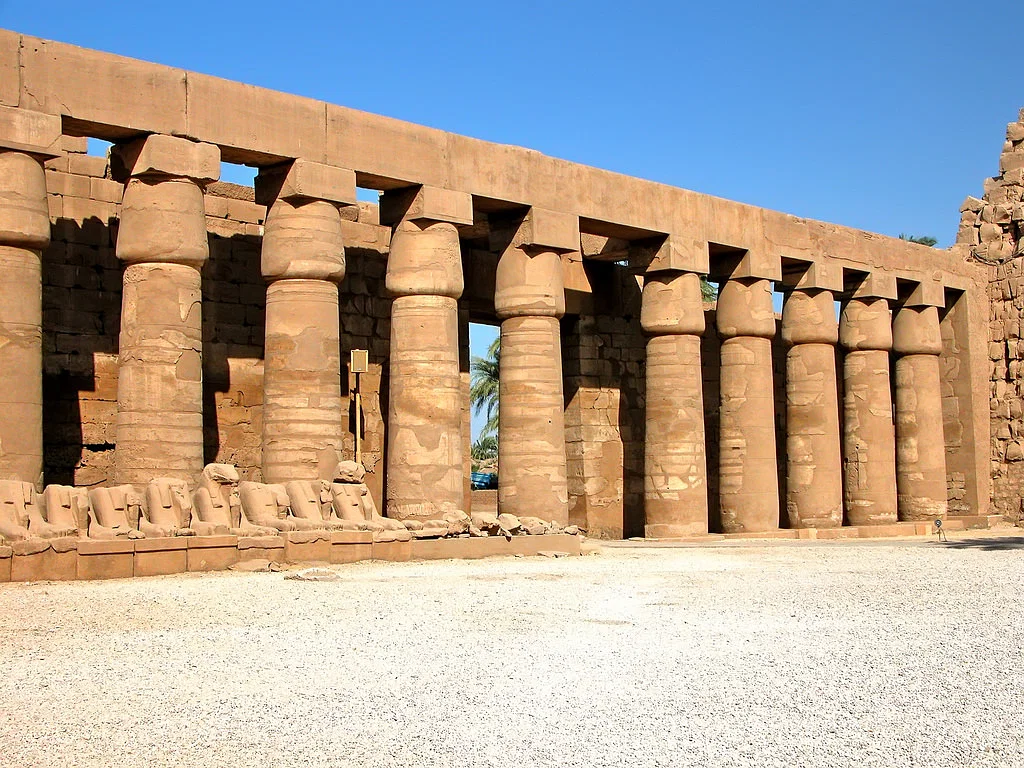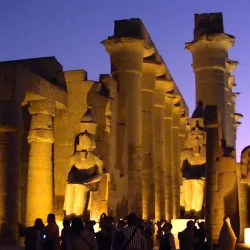Karnak Temple located in Luxor, Egypt, is one of the most impressive and largest temple complexes ever constructed. Spanning over 200 acres, it is a monumental testament to ancient Egyptian architecture, religion, and power. The complex is dedicated primarily to the Theban triad of Amun, Mut, and Khonsu, and it developed over a period of nearly 2,000 years, from the Middle Kingdom to the Ptolemaic era.
Karnak Historical Context

The origins of Karnak date back to the Middle Kingdom (around 2000 BCE), but most of the existing structures were built during the New Kingdom (1550-1070 BCE). Pharaohs from this period, including Hatshepsut, Thutmose III, Seti I, and Ramses II, contributed extensively to the complex. Each ruler expanded and embellished the site to demonstrate their devotion to the gods and their own divine right to rule.
Karnak Architectural Highlights

Karnak is renowned for its vast size and the grandeur of its structures. Key architectural features include:
- Hypostyle Hall: This colossal hall, built by Seti I and Ramses II, is one of the most iconic parts of Karnak. It covers an area of about 54,000 square feet and contains 134 massive columns, some standing 69 feet tall. The columns are adorned with intricate hieroglyphs and carvings, depicting scenes of religious rituals and pharaohs making offerings to the gods.
- Great Temple of Amun: The central and most significant temple within the Karnak complex, dedicated to the chief deity Amun-Ra. The temple includes a series of pylons (massive gateways), courtyards, halls, and sanctuaries. The Sacred Lake, used for purification rituals, is also part of this temple.
- Obelisks: Several pharaohs erected obelisks at Karnak, with the most notable being those of Hatshepsut and Thutmose III. These towering stone pillars were symbols of the sun god Ra and served as monumental markers of the pharaohs’ achievements.
- Precinct of Mut: Dedicated to the goddess Mut, the consort of Amun, this precinct features its own temple and sacred lake. It highlights the importance of Mut within the Theban triad.
- Precinct of Montu: Montu was a war god, and this precinct includes temples and structures dedicated to him. Although not as extensive as the Precinct of Amun, it underscores the complex’s multifaceted religious significance.
Religious and Cultural Significance
Karnak was not only a religious center but also a political one. The temple complex served as a stage for important state ceremonies, including the Opet Festival, during which statues of the gods Amun, Mut, and Khonsu were carried in a grand procession from Karnak to Luxor Temple. These festivals reinforced the divine connection between the gods and the pharaoh, legitimizing their rule.
Archaeological Discoveries
Excavations at Karnak have revealed numerous statues, stelae, and artifacts that provide insights into the religious and daily life of ancient Egyptians. The complex’s walls and columns are covered with hieroglyphic inscriptions that record historical events, religious texts, and royal decrees, making Karnak an invaluable resource for understanding ancient Egyptian history and culture.
Preservation and Tourism
Today, the Temple of Karnak is a UNESCO World Heritage Site and one of Egypt‘s most visited tourist attractions. Efforts to preserve and restore the complex are ongoing, as the site continues to face challenges from environmental factors and the sheer passage of time. Despite these challenges, Karnak remains a magnificent testament to the architectural and cultural achievements of ancient Egypt.
In summary, the Temple of Karnak is a monumental complex that encapsulates the grandeur and spiritual fervor of ancient Egyptian civilization. Its architectural marvels, religious significance, and historical richness make it a cornerstone of Egypt’s cultural heritage and a fascinating site for historians, archaeologists, and visitors alike.
Have you been captivated by the magic of Karnak? Share your experiences below!









0 Comment